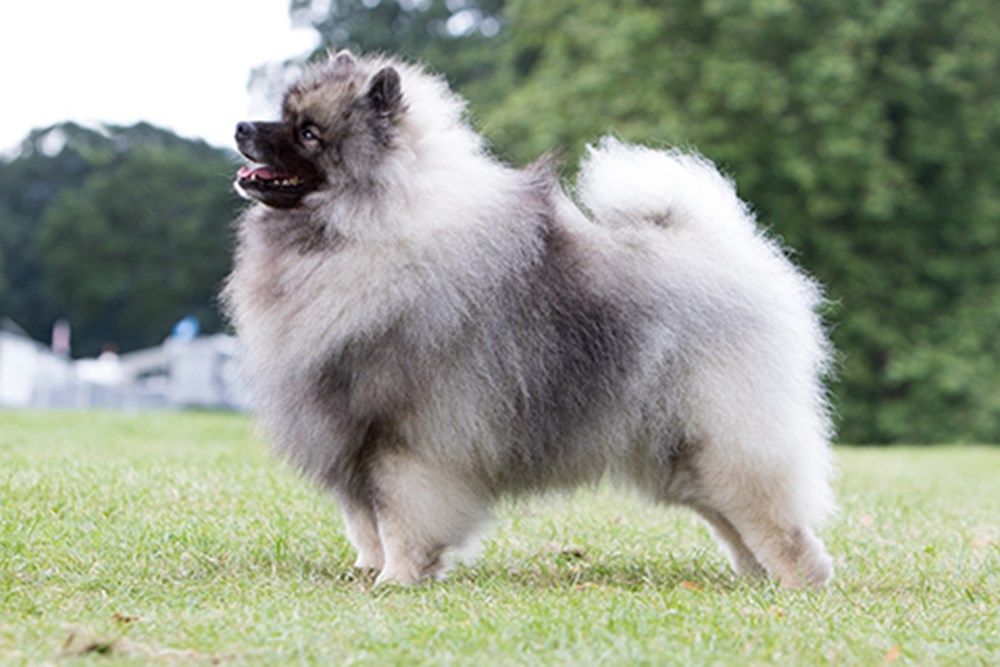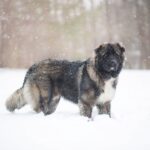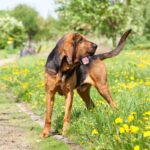You should learn everything there is to know about keeshond puppies before you adopt one. The following details the personality, health, grooming, training, exercise, etc. of a keeshond puppy.
The German Spitzes are the Keeshond’s closest relatives. The Keeshond is a medium-sized dog that originated in Holland. Other names for it include German Spitz, Wolfspitz, Smiling Dutchman, and others. With imports from Germany and the Netherlands, the breed was developed in England in the 19th century. Discover more about Keeshond puppies below!
About the Breed
The amiable Keeshond is a medium-sized spitz dog of ample coat, famous for the distinctive “spectacles” on his foxy face. The Kees was once a common sight on Holland’s canal barges and continues to be a representation of Dutch nationalism.
These square, sturdy companions share a common ancestor with other spitz breeds like Pomeranians and Samoyeds. Typically “spitzy,” Keeshonden have a foxy face, pointed ears, a thick coat, and a plumed tail carried high over the back.
A unique breed characteristic’and of one of the most charming hallmarks in all dogdom is the “spectacles.” An impression of a Kees wearing designer eyewear is created by the shading and markings around the eyes. The specs highlight a perceptive, alert expression.
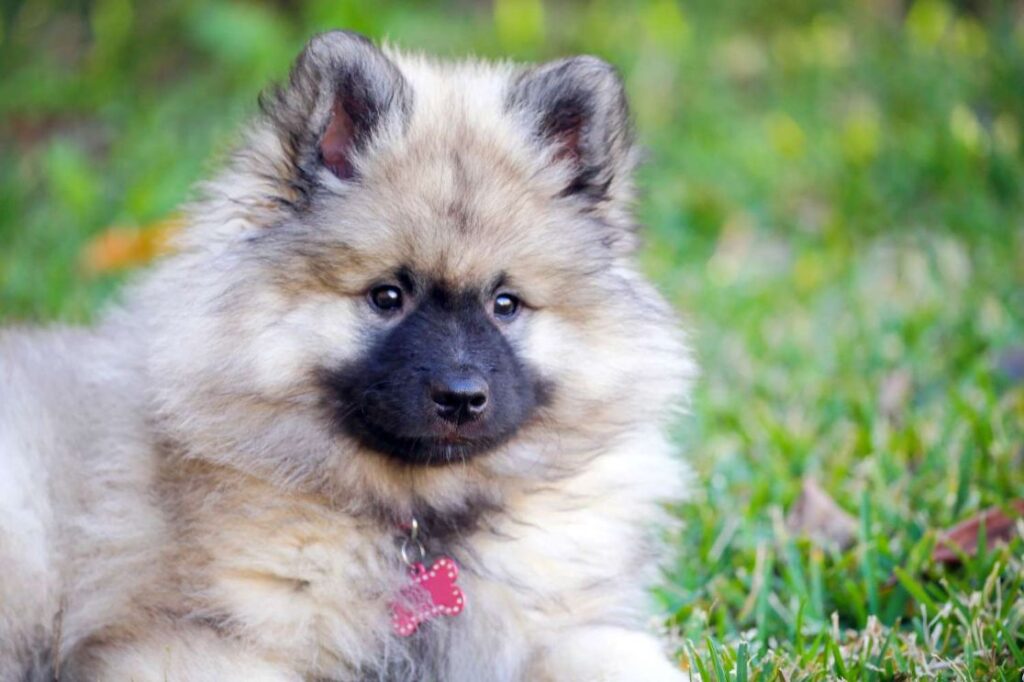
Nutrition
With the supervision and approval of your veterinarian, Keeshonden should thrive on high-quality dog food, whether it is manufactured commercially or prepared at home. They thrive on a low-carb fish-based diet, just like the majority of Northern breeds do. Whatever the dog’s age (puppy, adult, or senior), the diet should be suitable.
So keep an eye on your dog’s calorie intake and weight as some dogs are prone to obesity. Although giving too many treats can lead to obesity, they can be useful training aid.
Find out which foods fit the bill for dogs and which should be avoided. If you are worried about your dog’s weight or diet, consult your veterinarian. Fresh, clean water must always be accessible.
Personality
The Keeshond was developed more as a pet than as a watchdog. He is not a hunter, nor does he have an innate desire for any particular profession. He is first and foremost a loyal friend.
He is also very intelligent and teachable. In fact, he is so intelligent that he occasionally exhibits a playful side. These guys are unpredictable, so prepare yourself. Despite this, the breed is still able to train quickly and perform well in the obedience ring.
A Keeshond is a vivacious, perceptive dog with lots of character. He enjoys sharing his happiness with everyone when he is joyful or excited, frequently spinning in circles. His outgoing nature and love for both adults and children make him popular with everyone.
The Keeshond requires early socialization or being exposed to a wide variety of people, sights, sounds, and experiences, just like every other dog. In order to ensure that your Keeshond puppy develops into a well-rounded adult, socialization is important.
He should begin by enrolling in a kindergarten class for puppies. His social skills will also improve if you regularly host guests, as well as if you take him to crowded parks, pet-friendly stores, and on leisurely strolls to meet the neighbors.
Health
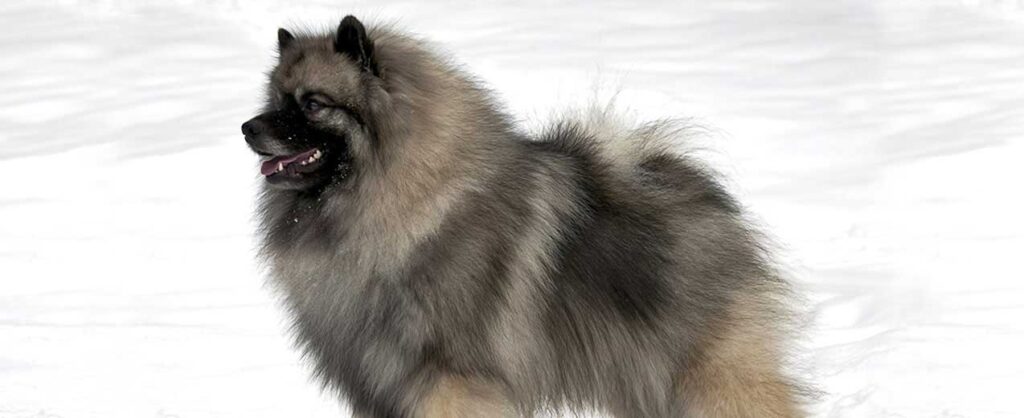
Although Keeshonds are typically healthy, they are susceptible to some health issues like all breeds. It’s important to be aware of these diseases if you’re thinking about getting a Keeshond, even though not all of them will affect the breed.
Addison’s Disease
This extremely serious condition also referred to as hypoadrenocorticism, is brought on by inadequate adrenal hormone production. The majority of affected dogs have poor appetites, vomit, and are listless.
It is simple to misdiagnose this disease until it reaches more advanced stages because these symptoms are hazy and can be confused with other conditions.
When a dog is under stress or when potassium levels rise to the point where they interfere with heart function and lead to serious shock and death, more severe symptoms appear. In order to confirm the diagnosis of Addison’s disease, your veterinarian may run a number of tests.
Hip Dysplasia
This inherited condition causes the thighbone to not fit tightly within the hip joint. On one or both of their back legs, some dogs exhibit pain and lameness, while others don’t show any overt signs of discomfort. (The most accurate method to identify the issue is X-ray screening.)
In either case, as the dog ages, arthritis may set in. If you’re buying a puppy, ask the breeder for documentation that the parents have undergone hip dysplasia testing and are healthy. Dogs with this condition shouldn’t be bred.
Progressive Retinal Atrophy (PRA)
It belongs to a group of eye conditions where the retina gradually deteriorates. Affected dogs develop night blindness early in the illness; as it worsens, they begin to lose their daytime vision. As long as their environment doesn’t change, many affected dogs adjust well to their diminished or lost vision.
Patellar Luxation
This issue, also known as slipped stifles, is typical in small dogs. Kneecaps are called patellas. Anatomical parts that have been dislocated, such as a bone at a joint, are luxated. Patellar luxation is a painful condition in which the knee joint (often of the back leg) slides in and out of place. Although many dogs with this condition live relatively normal lives, it can be crippling.
Diabetes Mellitus
The body cannot control blood sugar levels due to this disorder. The body’s cells require glucose (sugar) to burn for energy, and insulin is the key that allows glucose into the cell.
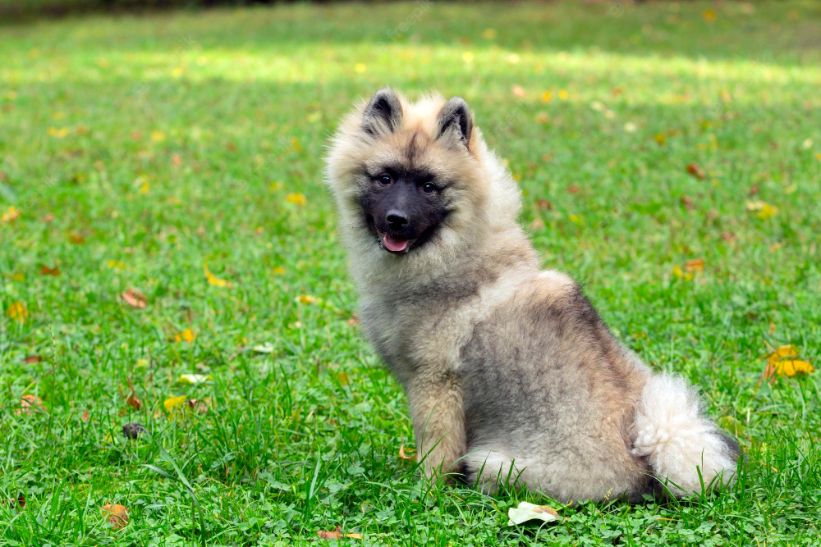
Without insulin, glucose cannot enter the cell, so the cells are “hungry” even though there are high levels of glucose circulating in the blood. A diabetic dog will eat more food to try and make up for the lack of insulin, but he will still lose weight because food is not being utilized properly.
Weight loss, increased appetite, and frequent urination are all signs of diabetes. In addition to insulin administration, diet can help manage diabetes.
Von Willebrand’s Disease
This blood condition, which can occur in both humans and dogs, has an impact on the clotting process. The symptoms of an affected dog include nosebleeds, bleeding gums, prolonged bleeding following surgery, prolonged bleeding throughout heat cycles or after whelping, and occasionally blood in the stool.
It can’t be cured, and this disorder is typically identified between the ages of three and five. Treatment options include cauterizing or suturing wounds, giving blood transfusions prior to surgery, and avoiding certain medications.
Hypothyroidism
This is a thyroid gland condition. As well as epilepsy, alopecia (hair loss), obesity, lethargy, hyperpigmentation, pyoderma, and other skin conditions, it is thought to be the cause of these conditions. Medication and dietary changes are used to treat it.
Cataracts
Poor vision is the result of cataracts, which obstruct the eye’s lens. The dog’s eye(s) will appear cloudy. Older people frequently develop cataracts, which can occasionally be surgically removed to enhance vision.
Epilepsy
This neurological condition is frequently inherited, but not always. It can result in mild or severe seizures, which can manifest as strange behavior (such as running frantically as though being pursued, staggering, or hiding) or even fall down, limbs rigid, and losing consciousness.
Although it can be frightening to witness a seizure, dogs with idiopathic epilepsy typically have a very good long-term outlook. It’s crucial to take your dog to the vet for a proper diagnosis (especially since seizures can have other causes) and treatment.
Allergies
Dogs frequently suffer from allergies, and the Keeshond is no exception.
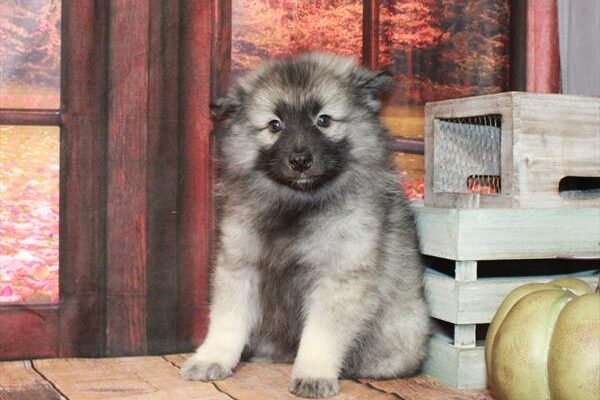
Food allergies, which are treated by removing particular foods from the dog’s diet, contact allergies, which are brought on by a reaction to a substance applied topically, like bedding, flea powders, dog shampoos, and other chemicals, and inhalant allergies, which are brought on by airborne allergens like pollen, dust, and mildew, are the three main categories of allergies.
The course of treatment depends on the underlying cause and may involve dietary changes, medication, and environmental modifications.
Find a reputable breeder who can provide you with the health clearances for both of your puppy’s parents if you’re buying a puppy. Health certifications attest to dogs having undergone testing and being declared free of a specific ailment.
For hip dysplasia, elbow dysplasia, hypothyroidism, von Willebrand’s disease, and thrombopenia from the Orthopedic Foundation for Animals (OFA), thrombopenia from Auburn University, and normal eyes from the Canine Eye Registry Foundation (CERF), you should anticipate seeing health clearances in Keeshonds. Checking the OFA website (offa.org) will allow you to confirm any necessary health clearances.
Grooming
Keeshonden do require routine grooming, but a weekly pin brushing usually takes care of it. By doing so, shedding is reduced and the undercoat is kept brushed out.
Cleanup around the feet, pads, and hocks is the only trimming required. Pet owners have two options: either they groom their dogs themselves every week and take them to the groomer every four to six weeks for a bath and blow-dry. A few days before the show weekend, show dogs are bathed.
Training
The fact that Kees is highly intelligent and trainable is a closely kept secret. Both obedience, where some of them are nationally ranked, and agility, where the first multiple MACH was a Keeshond named Molly, are sports in which they excel.
Many Kees have also made a name for themselves in the field of therapy. Kees are eager to please their trainers and pick up new information quickly.

They can get bored, so the trainer must keep up with them. It’s crucial to begin training your Kees when he is between 10 and 14 weeks old. They will pick up new material quickly and advance.
Training sessions for puppies and early socialization are advised. They will learn things without training, but maybe not the things you intended!
Exercise
A quick run or jog does wonder for Keeshond’s body, and it enjoys going for walks with its family. The dog will probably jump up and down when it’s time to go for a walk.
By taking a different route or just bringing the Keeshond along to that park meeting with a friend, you can add some variety to a routine walk.
Care
The Keeshond has mastered the art of being content in a relatively small space because it was originally bred for life on a barge before being developed as a companion dog. He can live contentedly in an apartment, a house with a big yard, or on a boat.
Keeshond’s desire to reside in the home with his family is more important than having enough space. Being a companion breed, he must be permitted to participate in as many aspects of his owners’ lives as possible.
He will get bored and start to bark more if left alone in the yard unattended for a long time with little to no contact with his family. If left alone, he might develop into a bothersome barker. Consider a different breed if you don’t intend to spend daily quality time with your Keeshond in the home.
The Keeshond does not need a lot of exercises, but all dogs benefit from it. For example, long-distance runners typically don’t consider him to be their preferred breed. But make sure you schedule at least one brisk walk each day for your health and his.
The Keeshond enjoys cool temperatures more than hot ones and dislikes them. Keep him inside, near fans, or in an air-conditioned home on hot days. Some Keeshonds also take pleasure in relaxing in a tiny wading pool of cool water.

